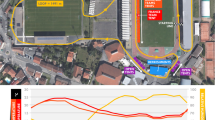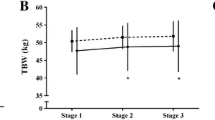Abstract
To describe the time course of plasma volume alterations and the changes in the plasma concentrations of hormones regulating water balance in relation to a marathon race, six experienced marathon runners (five men, one women) aged 28 (SD 6) years were studied during and for the 3 days following a treadmill marathon run at 68 (SD 5)% of maximal oxygen consumption. Haematocrit, haemoglobin, plasma protein (Prot) and electrolyte (Na+, K+) concentration, osmolality (osm), plasma concentrations of renin (Ren), aldosterone (Ald) and atrial natriuretic peptide (ANP) were determined at rest in a sitting position (T−30), and then after 30 min in an upright posture (R0), while running a marathon at 10 km (R10), 30 km (R30) and 42.2 km (Rend), and after the marathon at 30 min (T30), 60 min (T60), 120 min (T120) and 24 h (TD+1), 48 h (TD+2) and 72 h (TD+3). The changes in plasma volume (PV), Prot, osm and Na+ observed during the race were nonsignificant. Significant increases in plasma concentration of K+ [4.8 (SD 0.6) vs 5.5 (SD 0.6) mmol·l−1; P < 0.01], Ren [38 (SD 57) vs 197 (SD 145) pmol·l−1; P < 0.02] and Ald [175 (SD 142) vs 1632 (SD 490) pmol·−1; P < 0.01] were observed at Rend. A significant increase of ANP (P < 0.05) was only found after R10. Body mass significantly decreased by 2.0 kg (P < 0.01) during the race in spite of the ingestion of 1.46 (SD 0.34) 1 of a 5% glucose solution. Urinary volume and Na+ excretion dropped significantly after the completion of the marathon in comparison with the day before [2600 vs 1452 ml·day−1 (P < 0.02) and 161.3 vs 97.1 mmol·l−1 (P < 0.05)]. At TD+1 and TD+2 a significant increase in PV was noted, compared to T−30. The lack of a decrease in PV during the marathon may have been due to the production of 402 g of metabolic water and by the release of 1280 g of water stored in glycogen complexes in muscle and liver. Thus, the hormone response during the marathon may have been due to the effects of the exercise itself and not to the effects of dehydration. The postmarathon PV expansion may be explained by a protein shift to the intravascular space and by renal sodium retention.
Similar content being viewed by others
References
Bizollon CA, Rivière JF, Franchimont P, Faure A, Claustrat B (1974) Solid phase radioimmunoassay of plasma aldosterone, Steroids 23:809–821
Cade R, Packer D, Zauner C, Kaufmann D, Peterson J, Mars D, Privette M, Homen W, Fregly MJ, Rogers J (1992) Marathon running: physiological and chemical changes accompanying late-race functional deterioration. Eur J Appl Physiol 65:485–491
Colt ED, Wang J, Pierson RN Jr (1978) Effect on body water of running 10 miles. J Appl Physiol 45:999–1001
Consolazio CF, Johnson RE, Pecora LJ (1963) Physiological measurements of metabolic functions in man. McGraw Hill, New York, pp 313–317
Convertino VA (1991) Blood volume: its adaptation to endurance training. Med Sci Sports Exerc 23:1338–1348
Costill DL, Fink WJ (1974) Plasma volume changes following exercise and thermal dehydratation. J Appl Physiol 37:521–525
Davidson RJL, Robertson JD, Galea G, Maughan RJ (1987) Hematological changes associated with marathon running. Int J Sports Med 8:19–25
Edwards RJ, Harrison MH (1984) Intravascular volume and protein responses to running exercise. Med Sci Sports Exerc 16:247–255
Espiner EA, Nicholls MG, Yandle TG, Crozier IG, Cuneo RC, McCornick D, Ikeam H (1986) Studies on the secretion, metabolism and action of atrial natriuretic peptide in man. J Hypertens 4:585–591
Dickson DN, Wilkinson RL, Noakes TD (1982) Effects of ultramarathon training and racing on hematologic parameters and serum ferritin levels in well-trained athletes. Int J Sports Med 3:111–117
Fellmann N, Bedu M, Giry J, Pharmakis-Amadieu M, Bezou MJ, Barlet JP, Coudert J (1989) Hormonal, fluid, and electrolyte change during a 72-h recovery from a 24-h endurance running. Int J Sports Med 10:406–412
Follenius M, Brandenberger G (1988) Increase in atrial natriuretic peptide in response to physical exercise. Eur J Appl Physiol 57:159–162
Galbo H, Holst JJ, Christensen NJ (1975) Glucagon and plasma catecholamine responses to graded and prolonged exercise in man. J Appl Physiol 38:70–76
Gauquelin G, Gharib C (1990) Dosage radioimmunologique du facteur atrial natriurétique plasmatique: facteurs intervenant dans les modifications de sa concentration. Ann Biol Clin 48:551–554
Goodman JM, Logan AG, McLaughlin PR, Laprade A, Liu PP (1993) Atrial natriuretic peptide during acute and prolonged exercise in well-trained men. Int J Sports Med 14:185–190
Gore JC Scroop GC, Marker JD, Catcheside PG (1992) Plasma volume, osmolarity, total protein and electrolytes during treadmill running and cycle ergometer exercise. Eur J Appl Physiol: 65:302–310
Hagan RD, Diaz FJ, Horvath SM (1978) Plasma volume changes with movements to supine and standing positions. J Appl Physiol 45:414–418
Hultmann E (1967) Physiological role of muscle glycogen in man with special reference to exercise. J Am Heart Assoc 151:109
Kolka MA, Stephenson LA, Wilkerson JE (1982) Erythrocyte indices during a competitive marathon. J Appl Physiol 52:168–172
Kotchen TA, Hartley LH, Rice TW, Mougey EH, Jones LG, Mason JW (1971) Renin, norepinephrine, and epineophrine responses to graded exercises. J Appl Physiol 31:178–184
Kraemer RR, Brown BS (1986) Alterations in plasma-volume-corrected blood components of marathon runners and concomitant relationship to performance. Eur J Appl Physiol 55:579–584
Lacour JR, Padilla-Magunacelaya S, Barthelemy JC, Dormois D (1990) The energetics of middle-distance running. Eur J Appl Physiol 60:38–43
Lijnen P, Hespel P, M'Buyamba-Kabangu JR, Goris M, Lysens R, Vanden Eynde E, Fagard R, Amery A (1987) Plasma atrial natriuretic peptide and cyclic nucleotide levels before and after a marathon. J Appl Physiol 63:1180–1184
Lindinger MI, Sjøgaard G (1991) Potassium regulation during exercise and recovery Sport Med 11:382–401
Magazanik A, Shapiro Y, Meytes D, Meytes I (1974) Enzyme blood levels and water balance during marathon race. J Appl Physiol 36:214–217
Maron MB, Horvath SM, Wilkerson JE (1975) Acute blood biochemical alterations in response to marathon running. Eur J Appl Physiol 34:173–181
Maron MB, Horvath SM, Wilkerson JE (1977) Blood biochemical alterations during recovery from marathon running. Eur J Appl Physiol 36:231–238
Maughan RJ (1985) Thermoregulation and fluid balance in marathon competition at low ambient temperature. Int J Sports Med 6:15–19
McMahon LF, Ryan MJ, Larson D, Fisher RL (1984) Occult gastrointestinal blood loss in marathons runners. Ann Intern Med 100:846–847
Newmark St, Himathongkam T, Martin RP, Cooper KH, Rose LI (1976) Adrenocortical response to marathon running. J Clin Endocrinol Metab 42:393–394
Nilsson LH, Hultman E (1974) Liver and muscle glycogen in men after glucose and fructose infusion. Scand J Lab Invest 33:5–10
O'Brien MJ, Viguie CA, Mazzeo RS, Brooks GA (1993) Carbohydrate dependance during marathon running. Med Sci Sports Exerc 25:1009–1017
Olsson KE, Saltin B (1970) Variation in total body water with muscle glycogen changes in man. Acta Physiol Scand 80:11–18
Pivarnik JM, Leeds EM, Wilkerson JE (1984) Effects of endurance exercise on metabolic water production. J Appl Physiol 56:613–618
Poortmans JR, Haralambie G (1979) Biochemical changes in a 100-km run: protein in serum and urine. Eur J Appl Physiol 40:245–254
Pugh LGCE, Corbett JL, Johnson RH (1967) Rectal temperature, weight losses, and sweat rates in marathon running. J Appl Physiol 23:347–352
Röcker L, Kirsch KA, Heyduck B, Altenkirch HU (1989) Influence of prolonged physical exercise on plasma volume, plasma proteins, electrolytes, and fluid regulating hormones. Int J Sports Med 10:270–274
Rowell LB (1986) Human circulation. Regulation during physical stress. Oxford University Press, New York, pp 213–256
Rowell LB, Blackmon JR, Bruce RA (1964) Indocyanine green clearance and estimated hepatic blood flow during mild to maximal exercise in upright man. J Clin Invest 43:1677–1690
Scatchard G, Batchelder A, Brown A (1944) Chemical, clinical, and immunological studies on the products of human plasma fractionation. VI. The osmotic pressure of plasma and of serum albumin. J Clin Invest 23:458–464
Schmidt W, Massen N, Tegtbur U, Braumann M (1989) Changes in plasma volume and red cell formation after a marathon competition. Eur J Appl Physiol 58:453–458
Schneider EG, Davis JO, Baumber JS, Johnson JA (1970) The hepatic metabolism of renin and aldosterone. Circ Res 26–27 [Suppl 1]:175–183
Senay LC Jr (1972) Changes in plasma volume and protein contents during exposures of working men to various temperatures before and after acclimatation to heat: separation of the role of cutaneous and skeletal muscle circulation. J Physiol (Lond) 224:61–81
Staessen J, Fagard R, Hespel P, Lijnen P, Vanhees L, Amery A (1987) Plasma renin system during exercise in normal men. J Appl Physiol 63:188–194
Stewart JG, Ahlquist DA, McGill DB, Ilstrup DM, Schwartz S, Owen RA (1984) Gastronintestinal blood loss and anemia in runners. Ann Intern Med 100:843–845
Strauss MB, Davis RK, Rosenbaum JD, Rossmeisl EC (1951) “Water diuresis” produced during recumbency by the intravenous infusion of isotonic saline disolution. J Clin Invest 30:862–868
Wade CE, Hill LC, Hunt MM, Dressendorfer RH (1985) Plasma aldosterone and renal functions in runners during a 20-day road race. Eur J Appl Physiol 54:456–460
Author information
Authors and Affiliations
Rights and permissions
About this article
Cite this article
Pastene, J., Germain, M., Allevard, A.M. et al. Water balance during and after marathon running. Europ. J. Appl. Physiol. 73, 49–55 (1996). https://doi.org/10.1007/BF00262808
Accepted:
Issue Date:
DOI: https://doi.org/10.1007/BF00262808




